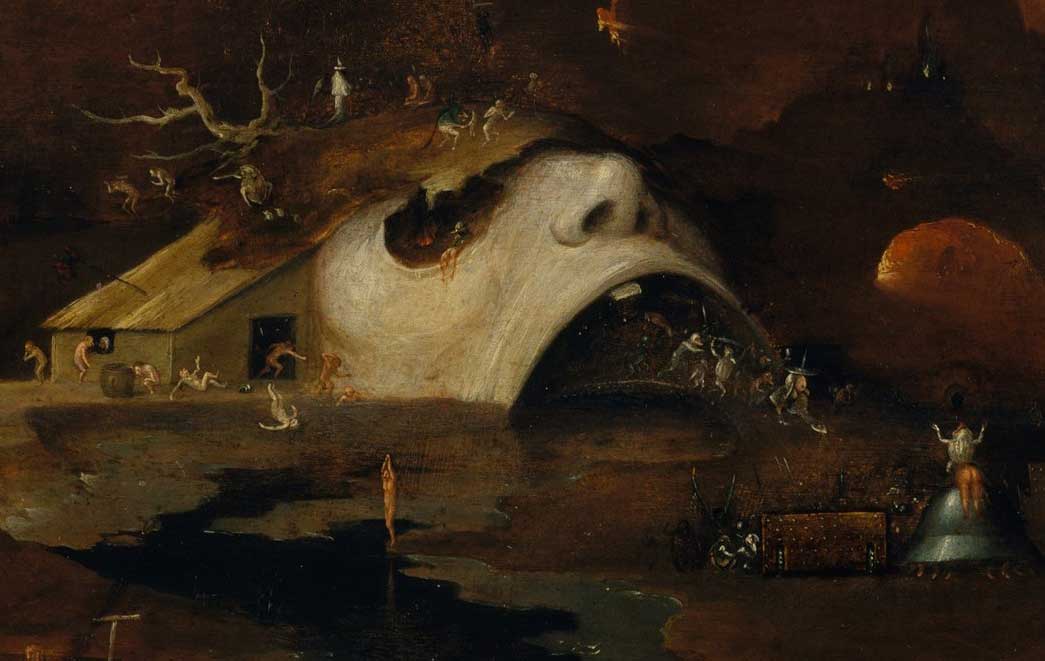Bosch’s fiery hell scenes remained enormously popular throughout Europe in the sixteenth century. A vast, desolate landscape with a burning city at the right and the river Styx at the left is the setting for this nightmarish vision, in which Christ breaks down the gates of hell to rescue the souls of the just. Gesturing in supplication towards him, Adam and Eve kneel on top of a ruinous tower. Behind them, Old Testament figures climb the winding stairs from the depths of hell, among them Abraham and Isaac with the sacrificial ram, and Noah with a model of the ark.

This scene illustrates a passage in the Gospel of Nicodemus from the Apocryphal New Testament (16:1–13; see Sintobin 1998). After the Crucifixion, Christ descended to the gates of Hell and demanded with a voice like thunder and wind, "Lift up your gates, Princes [of Hell] . . . and the King of Glory shall come in." With these words he rescued the souls of the just, the patriarchs, and the prophets from their torment. Christ is shown emerging through the gates that are embedded in a rocky formation. He is illuminated by a divine light that contrasts with the darkness of his surroundings. Demons try to prevent the gate from opening, in keeping with the apocryphal account in which the prince of Hell ordered his army to bar Christ from entering. Adam and Eve kneel on top of the ruins of a tower, directly across from the emerging Christ, gesturing in supplication. Behind them Old Testament figures make their way to the top of the ruins, carrying their attributes: Abraham and Isaac with the sacrificial ram, Noah with a model of the ark, Moses with the tablets of the law, David with a harp, the good thief from the Crucifixion with his cross, and Lot with his daughters. The man at the rear may be Diogenes, carrying his lantern. The view is from above, allowing for a full expanse of the highly detailed landscape with a burning city at the right and the river Styx at the left. Certain details, such as the owl and the flames, are traditional symbols of evil.

This highly detailed nightmarish vision is stylistically related to the work of Hieronymus Bosch, who lived from 1450 to 1516, but whose work continued to inspire Hell scenes painted throughout the sixteenth century. Certain details in the MMA painting can be found in Bosch’s Garden of Earthly Delights (Museo del Prado, Madrid) and theTemptation of Saint Anthony (Museu Nacional de Arte Antigua, Lisbon). The combination of grotesque Boschian details and the realistic depiction of a burning city are characteristic of the second third of the sixteenth century (Sintobin 1998). At this time Hell landscapes were particularly popular due in part to a belief held by many in northern Europe that the end of the world was imminent, a belief that was reflected in contemporary literature. The work of Bosch was so widely copied that the famous Spanish Humanist Felipe de Guevara (died 1560) complained about the number of fraudulent images in Bosch’s style in his Commentarios de la pintura of about 1560. The Temptation of Saint Anthony by the Workshop of Herri met de Bles (MMA 1976.100.1) is another example of a Boschian Hell scene from this time.


There has been some scholarly debate about the exact dating of this painting. Tolnay (1966) dates it 1530–50, while Corwin (1976) believes it to be part of the Bosch Revival group of the 1560s. Bergmans (1963) attributes a nearly identical painting (formerly in the Mangilli-Valmarana collection, Venice, now in a private collection in Brussels) to Gillis Mostaert, who died in 1560, and claims that the figure of Diogenes with a lantern does not appear in the North before 1559. The house in the shape of a head is a motif that comes from Bruegel’s drawing of the Temptation of Saint Anthony (Ashmolean Museum, Oxford). This drawing dates to 1559, supporting the dating of the MMA painting to 1550–60. Dendrochronological analysis performed by Dr. Peter Klein of the University of Hamburg revealed that the wood panel was probably not usable before the beginning of the sixteenth century. However, this date does not necessarily exclude the potential date of several decades later, as wood panels were sometimes stored for long periods of time before they were used by painters.
[2011; adapted from Sintobin 1998]
Provenance
Philipp, Graf von Saint Genois, Vienna (before 1895); [Kominik, Prague, after 1895]; Frantisek Kominik, Prague (until 1926); [Hugo Feigl, Prague, 1926; sold to MMA]
from the Met Museum's website.


|








